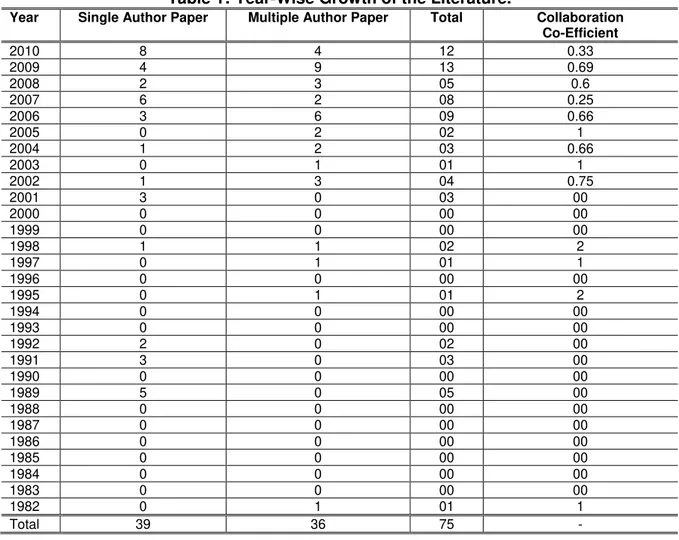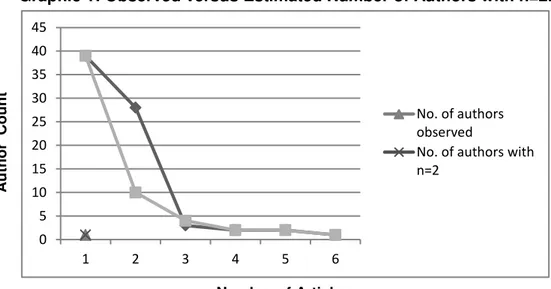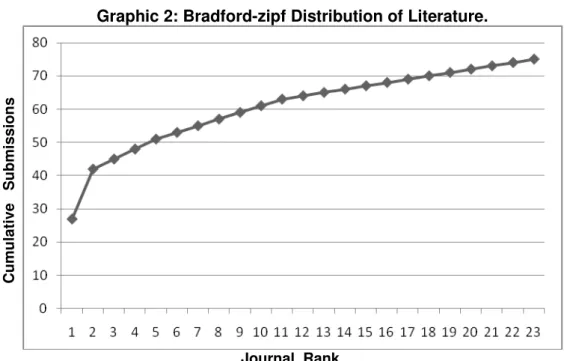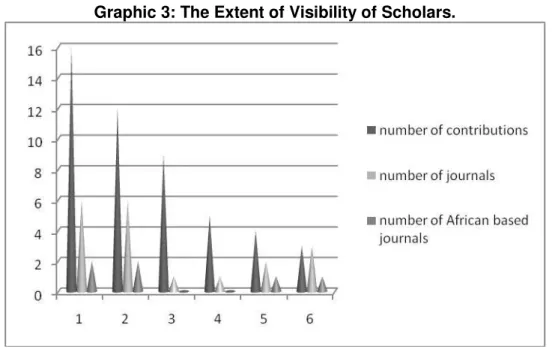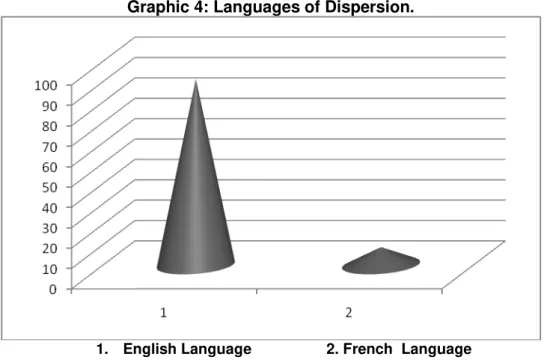VISIBILITY OF AFRICAN SCHOLARS
IN THE LITERATURE OF BIBLIOMETRICS
Yahya Ibrahim Harande
Department of Library and Information Sciences Bayero University Nigeria
ABSTRACT
This paper discusses the visibility of African scholars in the literature of Bibliometrics, as it appears in the Library and Information Science Abstract (LISA) from 1982-2010. Analysis was conducted on a list of 75 papers generated from the Abstract. The year-wise growth of the literature shows that single authorship dominates the literature, scoring 52% and the average number of publication per year was found to be 2.7. On the productivity of authors, Lotka’s formulation of inverse square law of scientific productivity was applied and found to be in harmony with the literature. Bradford-zipf Law for distribution of papers was also applied and found to be in conformity with the literature of Bibliometrics. Prolific authors were found to be 6 in number and their contributions falls between 3-16 papers within the 28 years period of the study. English language was found to be the dominant language with 91.3% score, and then followed by French with 8.7% score.
Keywords: Bibliometrics Studies; Lotka’s Law; Bradford’s Law; Information Science; African Scholars; LISA.
1 INTRODUCTION
collaborative researches, publishing articles in world re-known journals, constant appearance in popular indexing databases, attending international conferences, sharing results of scientific findings etc.
However this research focuses its attention on researches conducted by African scholars in Bibliometrics subject as it has been reported in LISA database. Popularity and comprehensive coverage of the database in library and information sciences justified the choice of LISA for the study.
Bibliometrics as defined by Pritchard (1969) refers to, “The application of mathematics and statistical methods to books and other media of communication”. Scholars and Scientists expand the scope of the definition to incorporate other aspects that are important and relevant to the field. Borgman and Furner (2002) define the term that, “Bibliometrics encompasses the measurement of documents and of document related processes”. In another dimension, Daisy (2006) says that, “Bibliometrics is a quantitative assessment of men`s cultural progress, including science and technology as may be revealed through bibliographic data. Bibliographic data are those that can be collected, derived or deciphered from different parameters as can be assign to a document”.
In addition to this, Claro and Costa (2011) offer that, “Bibliometrics of research performance currently use a divert set of indicators, focusing on attributes of journals, publications and citations”. The above view is silent on the producers of the intellectual contents of given documents, despite the reason that they occupy a very important and strategic position in advancing the course of knowledge.
Behrens and Luksch (2011) share the opinion that, “It is also of interest to consider the size and growth rate of the community of authors who published the literature […]”. Many Bibliometrics researches using databases were conducted. Moed (1988) expresses similar view that, “Databases containing Bibliometrics information on published scientific literature, play an important role in the field of quantitative studies of science and in the development and application of science and technology indicators”.
LISA database as their source of information for their research. They said, “Databases and their delivery mechanism have provided both the source of raw data as well as the analytical tools for informetric studies”.
Parmer, Kumar and Prakash (2004) also used LISA plus in their study on information seeking behavior. Parameswaran and Smitha (2001) conducted a bibliometric analysis on LISA database with the aim of determining the subjects covered by the articles. Anwar and Saeed (1999) utilized LISA plus database to study the authorship patterns of Pakistani librarians. Tsay (2008) used LISA database to conduct bibliometric analysis on the journal of the American Society for Information Science and Technology (JASIST). Also Pulgarín-Guerrero and Gil-Leiva (2004) conducted bibliometric analysis on indexing literature using the LISA database. Wormell (2000) studied Libri’s position and contributions in the field of Library and Information Science and one of the tools used as database was LISA.
Perryman (2009) studied thematic categorization and analysis of peer reviewed papers using the LISA database. Gonzalez-Alcaide et al. (2008) analyzed journal articles that appeared in LISA database, focusing on library and information research areas. Lee, Kim and Kim (2010) analyzed the research domain “digital library” using LISA as database. Wilson (2010) content analyzed conference entries that appeared in LISA database. Al Ansari (2008) retrieved relevant information from LISA on his study of library and information science literature on the Gulf Co-Operation Council. Julien, Pecoskie and Reed (2011) content analyzed data on information behavior research from the LISA database.
2 OBJECTIVES OF THE STUDY
The main objective of the study is to explore quantitatively the contributions of African scholars in the literature of Bibliometrics as exhibited in the LISA database.
3 METHODOLOGY
Using the library and information science abstracts (LISA) database, this study investigated the contributions of the African scholars in the literature of Bibliometrics, covering the period from 1982-2010. LISA is one of the globally recognized databases in the discipline of library and information science. It is considered as one of the most comprehensive database that organizes information sources on library and information science discipline.
This study only considers journal articles on Bibliometrics emanating from African scholars. The articles were principally identified using the search terms “Bibliometrics” AND “Africa”. As a result of this exercise a list of 75 papers was generated. The analysis was conducted on the generated list of journal articles. Year-wise growth of the literature and productivity was achieved by using collaborative co-efficient technique. Lotka`s inverse square law of scientific productivity was applied to determine the productivity of authors. The law can be expressed as:
X n Y = C where: x - Number of articles
y - Number of authors with x articles n - Is an exponent with value of 2
c - Is a constant depending on the discipline.
Bradford-zipf (1948) law was applied to determine the extent of spread of the literature. Three zones are represented in this law. The ratio between the number of journals in the zone is observed to be 1: n: n: n2…The first zone consist of the core journals on the subject. The journals that constitute the 2nd and 3rd zones decrease in their productivity progressively.
4 RESULTS
4.1 Growth of the Literature
During the 28 years period (1982-2010) African scholars have contributed a total of 75 publications in the literature of Bibliometrics as exhibited by the LISA database. Table 1 presents the year-wise growth of the literature exhibiting authorship pattern and collaborative trend among scientists and scholars. The average number per year was found to be 2.7 with the highest being 12 in 2009. Single authorship dominates the literature with 52% while the multi-authored publication scored 48%. The highest collaboration co-efficient (number of collaborative papers divided by total number of papers published) was found in 2009.
Table 1: Year-Wise Growth of the Literature.
Year Single Author Paper Multiple Author Paper Total Collaboration Co-Efficient
2010 8 4 12 0.33
2009 4 9 13 0.69
2008 2 3 05 0.6
2007 6 2 08 0.25
2006 3 6 09 0.66
2005 0 2 02 1
2004 1 2 03 0.66
2003 0 1 01 1
2002 1 3 04 0.75
2001 3 0 03 00
2000 0 0 00 00
1999 0 0 00 00
1998 1 1 02 2
1997 0 1 01 1
1996 0 0 00 00
1995 0 1 01 2
1994 0 0 00 00
1993 0 0 00 00
1992 2 0 02 00
1991 3 0 03 00
1990 0 0 00 00
1989 5 0 05 00
1988 0 0 00 00
1987 0 0 00 00
1986 0 0 00 00
1985 0 0 00 00
1984 0 0 00 00
1983 0 0 00 00
1982 0 1 01 1
4.2 Author Productivity and Lotka`s Law
The author data shows that 129 authors produced 75 papers. Table 2 presents author productivity data in accordance with Lotka`s law. From the Table 39 (6.50%) produced one article, 28 (4.66%) produced two articles and so forth. The calculation considers n= 2, C= 39 and the values obtained were shown in the fourth column of the Table 2. The contributions of authors in this literature were counted manually. And the nature of individual author contributions ranges from 1-6 papers.
Table 2: Author Productivity for Lotka’s Law.
No. of Articles(x) No. of Authors Observed (y)
Percentage of Authors No. of Authors With n=2
1 39 6.50 39
2 28 4.66 10
3 03 0.50 4
4 02 0.33 2
5 02 0.33 2
6 01 0.16 2
The Graphic 1 also shows observed versus estimated number of authors with, n= 2 taking into consideration the number of articles from 1-6. The fit is visually clear the observed and estimated lines can only be distinguished on the upper part of the Graphic. Therefore one can say that, Lotka`s formulation of inverse square law of scientific productivity applies to the literature of Bibliometrics.
Graphic 1: Observed versus Estimated Number of Authors with n=2.
0 5 10 15 20 25 30 35 40 45
1 2 3 4 5 6
No. of authors
observed
No. of authors with
n=2
Number of Articles.
Au
th
o
r Cou
n
4.3 Bradford`s Law for Distribution of Papers
Table 3 enlist the 23 journals that published 75 articles relating to Bibliometrics literature during 1982-2010.These journals are ranked according to decreasing order of their productivity. Two journals were identified as core, they are,
Scientometrics which published 27 (36%) and South African Journal of Library and
Information Science which published 15 (20%) on various aspects of Bibliometrics.
Table 3: Ranking of Contributing Periodicals.
Rank No. of Sub. Cum. Sub. Journal Title
1 27 27 Scientometrics
2 15 42 South African Journal of Library and Information Science 3 3 45 International Library Review
4 3 48 Mousaion
5 3 51 African Journal of Library Archives & Information Science 6 2 53 International Information and Library Review
7 2 55 Journal of Information Science 8 2 57 Herald of Library Science
9 2 59 Library Review
10 2 61 Journal of Medical Library Association
11 2 63 Malaysian Journal of Library and Information Science 12 1 64 Journal of Informetrics
13 1 65 Journal of the American Society for Information Science
14 1 66 Webology
15 1 67 Science and Technology Libraries
16 1 68 Library and Information Science Research 17 1 69 Journal of Strategic Information System 18 1 70 Revista Española de Documentación Científica 19 1 71 Library Philosophy and Practice
20 1 72 Information Development 21 1 73 Information Research
22 1 74 Libri
23 1 75 Third World Libraries
Graphic 2: Bradford-zipf Distribution of Literature.
Journal Rank.
4.4 Prolific Authors in the Literature
Six scholars were identified as prolific authors in the literature of Bibliometrics during the period of the study. The range of their contribution falls between 3-16 papers in the 28 years of the study. Table 4 gives the breakdown of these authors and their extent of contribution during the period. The top on the ranking of the authors was Onyencha who contributed 16 papers (21.3%), these papers were published in 6 journals out of which 2 are African based journals. Ocholla contributed 12 papers (16%), these papers were also published in 6 journals, out of which 2 are African based journals. Pouris contributed 9 papers in 1 journal. Also Sooryamoorthy contributed 5 papers in 1 journal. Jacobs contributed 4 papers in 2 journals out of which 1 is African based journal. Nwagwu contributed 3 papers out of which 1 is African based journal.
Table 4: Prolific Authors in the Literature.
Name of Author Number of Contributions Number of Journals African Based Journals
Onyencha, B. 16 6 2
Ocholla, D. 12 6 2 Pouris, A. 09 1 0 Sooryamoorthy, R. 05 1 0 Jacobs, D. 04 2 0 Nwagwu, W. 03 3 1
Total 49 19 6
Cu
mu
lative
S
u
b
mi
ss
ion
Graphic 3 clearly show the extent to which the scholars are visible in Africa and beyond. These prolific authors altogether produced 49 journal articles in 19 journals out of which 6 are African based journals. Counting the contribution of each scholar was done manually to be able to determine the number of papers they contribute during the period of the study.
Graphic 3: The Extent of Visibility of Scholars.
4.5 Language of Dispersion of the Literature
The data on Table 5 exhibited that English language dominates the dispersion of the literature. This can be seen easily from the Table that English scored 91.3% followed by French language which scored 8.7%.
Table 5: Language of Dispersion of the Literature.
Language Percentage
English 91.3
French 8.7
Graphic 4 further clarifies the extent of language of dispersion of the literature. From the figure one can see clearly that English language dominates the greater part of the chart.
Graphic 4: Languages of Dispersion.
1. English Language 2. French Language
DISCUSSION
The trend of growth of the literature has shown that single authorship was announced more than the multi-authored approach. Therefore, growth of the literature from the perspectives of LISA database could be said to be positively related with single authorship. The Table 1 has clearly shown the extent to which growth of the literature could be determined for the 28 years period of the study.
scholar could be determined through the number of journals the scholar`s article appeared. The number 6 recorded out of 19 for the African based journals clearly indicate that, African scholars are more visible on the journals published outside the African continent. English language has been the dominant language of dispersion of the literature based on the entries recorded from LISA database.
Implications of the study:
Use of database e.g. LISA gives opportunity for Bibliometrics researches to be conducted from various dimensions.
Scholars from Africa could improve their visibility by publishing consistently on journals, which are indexed in LISA database.
Journals published in African countries in the area of library and information science could improve their visibility by consistently appearing in major indexing databases, e.g. LISA.
It could be used for organization, dissemination and management of the subject literature “Bibliometrics”.
Similar research could be conducted with other databases.
REFERENCES
AL-ANSARI, H. H. Library and information science literature on the gulf co-operation Council (GCC) countries: A bibliographic analysis. Technical Series Quarterly, v.25, n.3, p.21-34, 2008.
ANWAR, M.; SAEED, H. Pakistani librarians as authors: A Bibliometrics study of citation in LISA-Plus. Asian Librarian, v.8, n.1, p.35-42, 1999.
BEHRENS, H.; LUKSCH, P. Mathematics 1868-2008: A Bibliometrics analysis. Scientometrics, v.86, n.1, p.179-194, Jan. 2011.
BORGMAN, C. L.; FURNER, J. Scholarly communication and Bibliometrics. Annual Review of Information Science and Technology, v.36, n.4, p.3-72, 2002.
CLARO, J.; COSTA, C. A. V. A made to measure indicator for cross-disciplinary Bibliometrics ranking of researchers’ performance. Scientometrics, v.86, n.1, p.113-123, Jan. 2011.
GONZALEZ-ALCAIDE, G. et al. Library and Information Science research areas: Analysis of journal articles in LISA. Journal of the American Society for
Information Science and Technology, v.59, n.1, p.150-154, 2008.
HOOD, W. W.; WILSON, C. S. Informetric studies using databases: opportunities and challenges. Scientometrics, v.58, n.3, p.587-608, Nov. 2003.
JULIEN, H.; PECOSKIE, J.; REED, K. Trends in information behavior research, 1999-2008: A content analysis. Library and Information Science Research, v.33, p.19-24, Jan. 2011.
LEE, J.Y.; KIM, H.; KIM, P.J. Domain analysis with text mining: Analysis of digital library research trends using profiling methods. Journal of Information Science, v.36, n.2, 144-161, Apr. 2010.
MOED, H. J. The use of on-line databases for Bibliometrics analysis. In: EGGHE, L.; ROUSSEAU, R. (Ed.). Informetrics 87/88. Belgium: Diepenbeek, 1988. p.133-146 (Proceedings 1st International Conference on Bibliometrics and Theorectical Aspects of Information Retrieval – 1989)
PARMAR, A. S.; KUMAR, S. A.; PRAKASH, T. Information seeking behavior related literature: A LISA Plus based Bibliometrics analysis. Journal of Library and
Information Science, v.29, n.1/2, p.55-64, 2004.
PARAMESWARAN, M.; SMITHA, K. G. Bibliometrics analysis of LISA. Annals of Library and Information Studies, v.48, n.4, p.149-156, 2001.
PERRYMAN, C. Thematic categorization and analysis of peer reviewed articles in the LISA Database, 2004-2005. A Review of: Gonzalez-Alcaide, Gregorio, Lourdes Castello-Cogolles, Carolina Navarro-Molina et al. Library and Information Science Research Areas: Analysis of Journal Articles in LISA. Journal of the American Society for Information Science and Technology 59.1 (2008): 150-4. Evidence Based Library and Information Practice, v.4, n.1, 2009.
PERSSON, O. et al. Research collaboration at Nordic Universities. Scientometrics, v.39, n2, p.209-223, Jul. 1997.
PRITCHARD, A. Statistical Bibliography or Bibliometrics? Journal of Documentation, v.25, n.4, p.348-349, 1969.
TSAY, M. Journal Bibliometric analysis: A case study on the Journal of the American Society for Information science and Technology. Malaysian Journal of Library and Information Science, v.13, n.2, p.121-139, 2008.
WILSON, V. Something for everyone? A content analysis of provincial library
association conference sessions. Partnership: The Canadian Journal of Library and Information Practice and Research, v.5, n.1, 2010.
WORMELL, I. Libri`s golden jubilee in a Bibliometric mirror. Libri, v.50, p.75-84, 2000.
Yahya Ibrahim Harande
Department of Library and Information Sciences Faculty of Education
Bayero University
P.M.B. 3011 Kano - Nigeria
